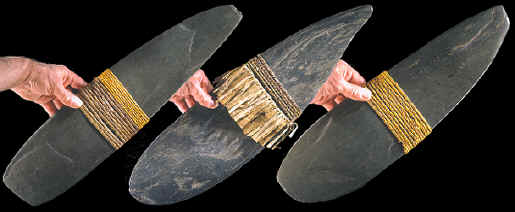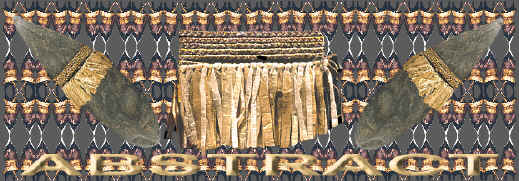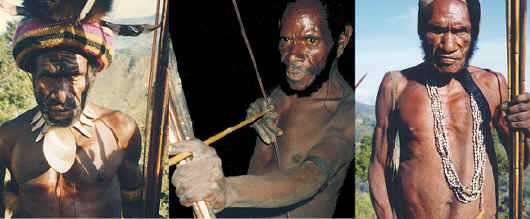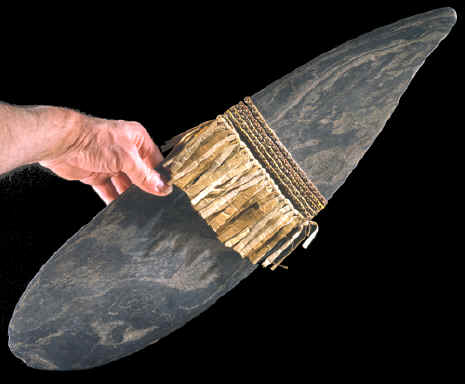|
PAGE
1
DISPLAY-
EXCHANGE
STONES
DANI CULTURE
IRIAN
JAYA, INDONESIA
ISLAND OF NEW GUINEA
EUROPEAN CONTACT
PAGE 1
OF 4 PAGES
COPYRIGHT
JANUARY 31, 2004 PETER A. BOSTROM

DECORATED
DISPLAY-EXCHANGE STONES
PETE
BOSTROM COLLECTION |
|
|

DISPLAY-EXCHANGE
&
SACRED STONES
DANI
CULTURE
IRIAN JAYA, INDONESIA
The artifacts illustrated in this article were manufactured and
used by cultures living in the Central Highlands on the island of
New Guinea in Irian Jaya, Indonesia. They were collected over a
period of 50 years or more. New Guinea has offered Anthropologists a rare
opportunity to observe and record stone tools still being
manufactured and used both domestically and in various types of ceremonies. Within recent years, during the 20th century, the
Dani were living very much the same way a Stone Age Neolithic
culture would have been living thousands of years ago. |
|
|
"Throughout prehistory, the recorded
presence of symbolic stones, when they could be identified, not just
stone tools, has intrigued us."---1999,
O. W. "Bud" Hampton, "Culture of Stone." p. 99.
"All
sacred stones are called habo. All exchange stones are called je, and
there are at least fourteen specific names for different kinds of je."---1970,
Karl G. Heider,"The Dugum Dani," p. 288.
"No
phenomenon, either real or imagined, is of greater significance to Dani
life than their belief in ghosts".---1968,
Robert Gardner & Karl G. Heider, "Gardens of War," p. 87.

PICTURE
CREDIT AND COPYRIGHT, AL KONDER & SANDY DONNELLY
WARRIORS OF THE DANI
The three men pictured above are Dani tribesmen. The man on the left is
Tengari Alat from the village of Meledik. He claims to have killed five
men. The man in the center is Yukiur from the village of Ekaba and he
claims to have kill one man with this bow. The man on the right is Leber
from the village of Meledik. Their claims may or may not be true but they are
all armed with the same types of bow and arrow weapons still being carried today.
DISPLAY-EXCHANGE
STONES
IRIAN JAYA, INDONESIA
Archaeologists find stone artifacts on ancient sites all over the world. Most
of them were used to process food, carve wood, make cloths or weapons. These
artifacts are easy to identify. But some have no obvious use and may even seem
mysterious. They are the ones we call
enigmatic, problematic or ceremonial objects. Sometimes there are clues that
indicate how they were used. For example, Egyptian hieroglyphics illustrate the
ritual feeding of the dead ceremony with a fishtail biface. So we know at
least one way that artifact was used. But the best way anthropologists have
learned the most about ceremonial objects are from people still using them.
New Guinea is a good example of such a place.
|
|

CLICK ON
PICTURE FOR LARGE TRIPLE IMAGE
A DECORATED DISPLAY-EXCHANGE
STONE
DANI
CULTURE
IRIAN JAYA, INDONESIA
PETE BOSTROM COLLECTION
This display-exchange stone was collected by a geologist sometime in
the late 1960's in western Papua New Guinea. It is decorated with a
common female skirt motif. This one has two different styles of
skirts. One style is the brief wrap around wedding skirt (jogal)
made of orchid fiber cording. The other is a drop skirt (sali) that
is usually worn by young girls and is made of flattened reeds. One of the
wrap around skirts is hidden under the drop skirt and it is made of
bright yellow orchid fiber. Although the picture doesn't show it,
the color of the stone is actually dark green. The surface has been
well smoothed on both sides and the edges. This display-exchange
stone measures 22 9/16 inches (57.3 cm) long, 5 7/7 inches (14.9 cm)
wide and 9/16 inch (1.4 cm) thick. It is slightly wider than the
widest (5 1/2 inches (14 cm) of the 38 examples measured by Hampton
in "Culture of Stone." This display-exchange stone might
be estimated to be worth one medium sized pig (1999: Hampton, pp. 113-114) |
|
|
New Guinea has contributed a great deal of information to anthropologists who
study stone tool making technologies and the use of stone tools. The extremely isolated interior
region can be seen as a virtual time capsule of knowledge. It's believed that
the first people arrived on the island as much as 50,000 years ago. As
people moved into the rugged mountainous interior, many different groups
developed their own separate languages and tribal cultures. There are over 750
distinct languages spoken in New Guinea which represents about one third of
the world's indigenous languages.
|
|
CONTINUE ON TO PAGE
TWO
|
|
"REFERENCES"
1968,
Gardner, Robert & Heider, Karl G., "Gardens of War, Life and
Death in the New Guinea Stone Age," p. 87.
1970, Heider, Karl G., "The Dugum Dani," p. 288.
1978, Marcus, Rebecca B., "Survivors of The Stone Age," p.
113.
1998, Konder, Albert, Personal Communication, Letter.
1999, Hampton, O. W., "Culture of Stone, Sacred and Profane Uses
of Stone Among the Dani,"
|
|
HOME
ORDERING |



